There are a few DIY methods to soundproof thin walls in apartments, like hanging soundproof blankets, curtains, acoustic panels, and mass-loaded vinyl. But if you can make the investment, professional construction work will yield the best results.
Airborne noise and impact noise transmission between the typical thin walls of many apartments in the United States can cause much distraction and disruption in residents’ lives.
For example, having a child and a neighboring dog that barks a lot can disrupt the baby’s sleep, extending to the parents’ own poor sleep quality!
Fortunately, any thin wall can get soundproofing treatment! Start reading below to find out how.
Overview of Thin Apartment Walls
Before diving into the different ways to soundproof thin apartment walls, let’s first talk about the problems with thin walls.
Shared walls are unavoidable in an apartment building. Some walls can stop noise better than others, but it’s pretty standard to have some level of noise transfer between them.
If your building has a low STC (sound transmission class), you’d probably have to supplement the sound isolation in your space for a better living experience.
The Disadvantages of Thin Apartment Walls
Unfortunately, having shared walls entails enduring unwanted noise. This means you’ll probably have difficulty sleeping if you are sensitive to sounds.
Another major concern is the lack of privacy. If you can hear your neighbors, they can surely hear you too.
In general, such noise just makes life less comfortable.
Can You Really Soundproof a Thin Wall?
Yes, but it’s important to set your expectations accordingly. Totally blocking sound requires the help of a professional, but there are sound reduction techniques you can do if that’s not an option.
How to Soundproof Apartment Walls in 7 Different Ways
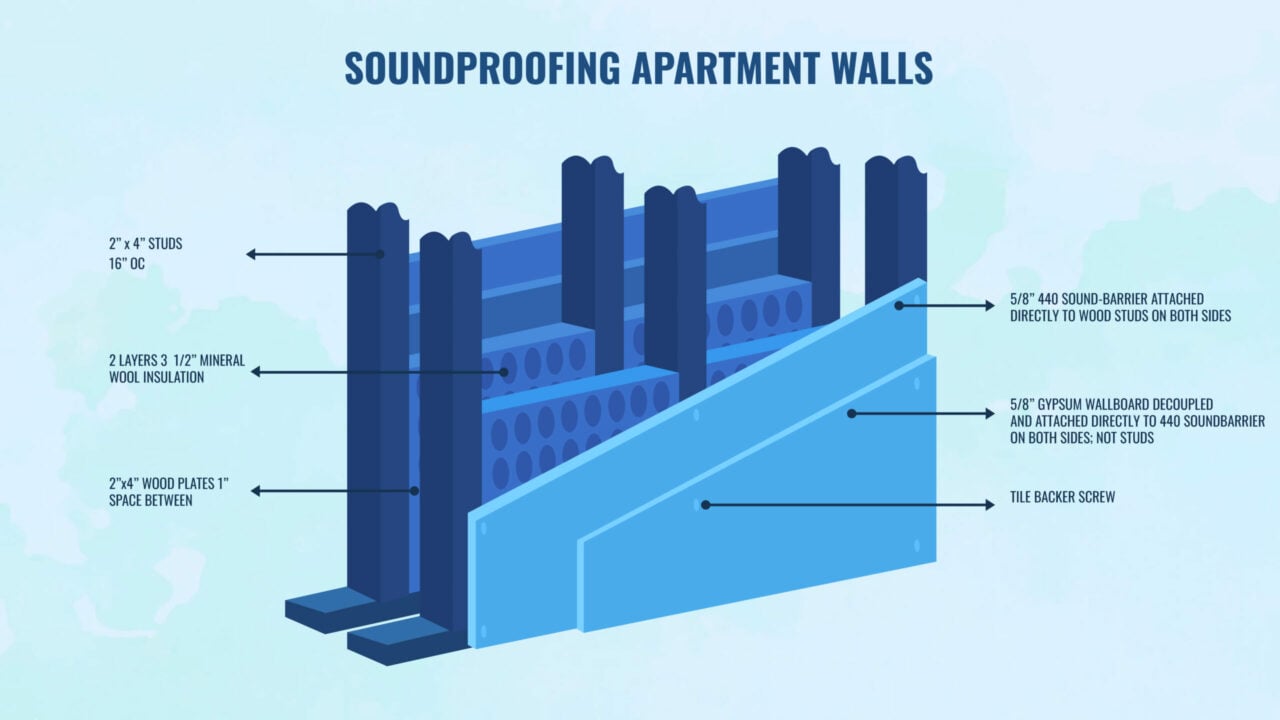
Here are some ways to soundproof thin apartment walls and reduce noise effectively. You can easily install these soundproofing materials like a professional!
But note that our best advice is to use a couple or a handful of these techniques together.
1. Use Soundproofing Blankets, Thick Blankets, or Heavy Curtains
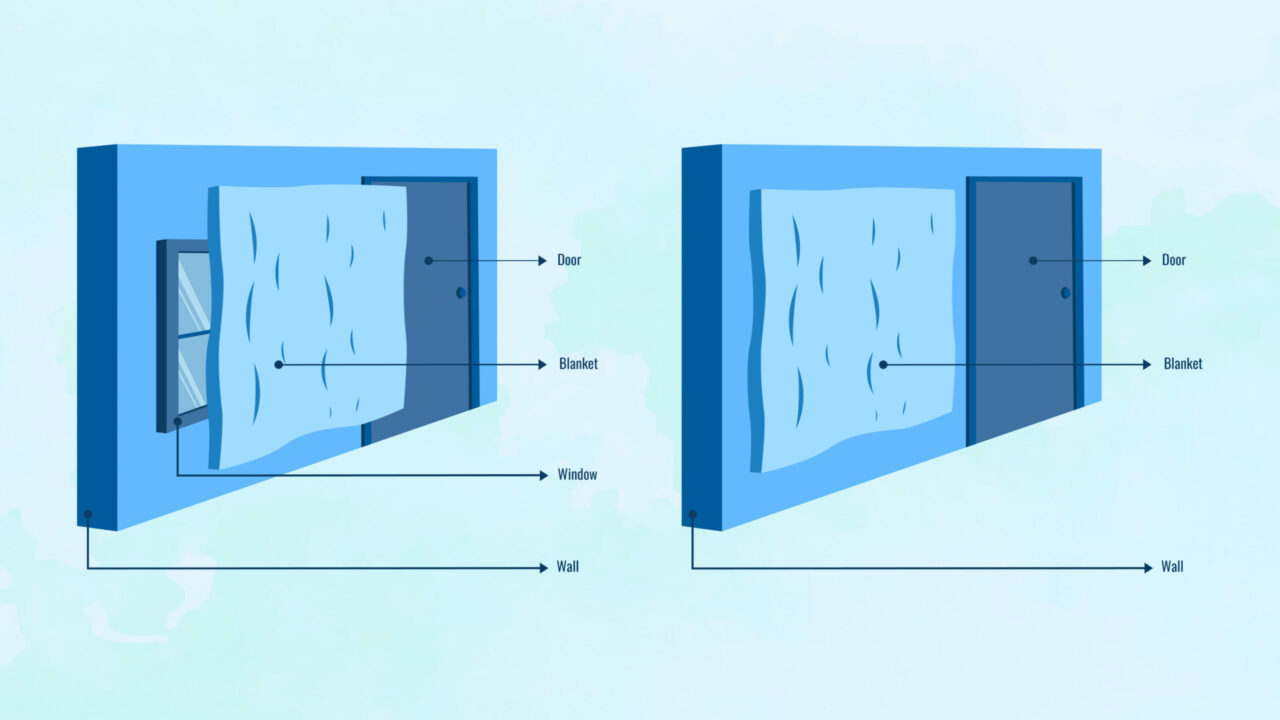
A soundproofing blanket can eliminate up to 50% of the noise! The textile is made up of layers of sound-absorbing materials (including mass-loaded vinyl) that are great for thin walls.
Start by identifying which parts of your walls are the weakest (i.e., the parts that allow in the most noise). These parts can be the house pipes or the thinnest portions of the walls.
You’ll want to place your blankets in these spots. Some mounting putty can be helpful for this purpose, or you can nail them against walls if they have grommets and your lease allows it.
PRO TIP
Try to leave a gap between the blanket and the wall for better sound dispersion. We also suggest having someone to help with this as they may be a bit heavy to install by yourself.
These blankets typically come in limited color options (mostly black), so they might not fit the aesthetic of every room.
If that is a problem, or if you’re on a tight budget, you can take a thick curtain or blanket that you already own and use that instead. Keep in mind that it won’t be as effective.
2. Put Furniture or Artwork Against the Wall
If aesthetics is one of your concerns, you can beef up a thin wall to help decrease noise by strategically placing your furniture and adding some lovely wall art.
A piece of furniture that can be particularly effective at reducing noise is a bookcase.
Not only does it have a good thickness to it, but the books you can fill it with have the ability to absorb sounds, too!
Wardrobes and closets are also good options. If you know where your walls’ weak spots are, a well-placed dresser with some artwork hung above it can look and function well for you.
3. Add Mass With Mass Loaded Vinyl
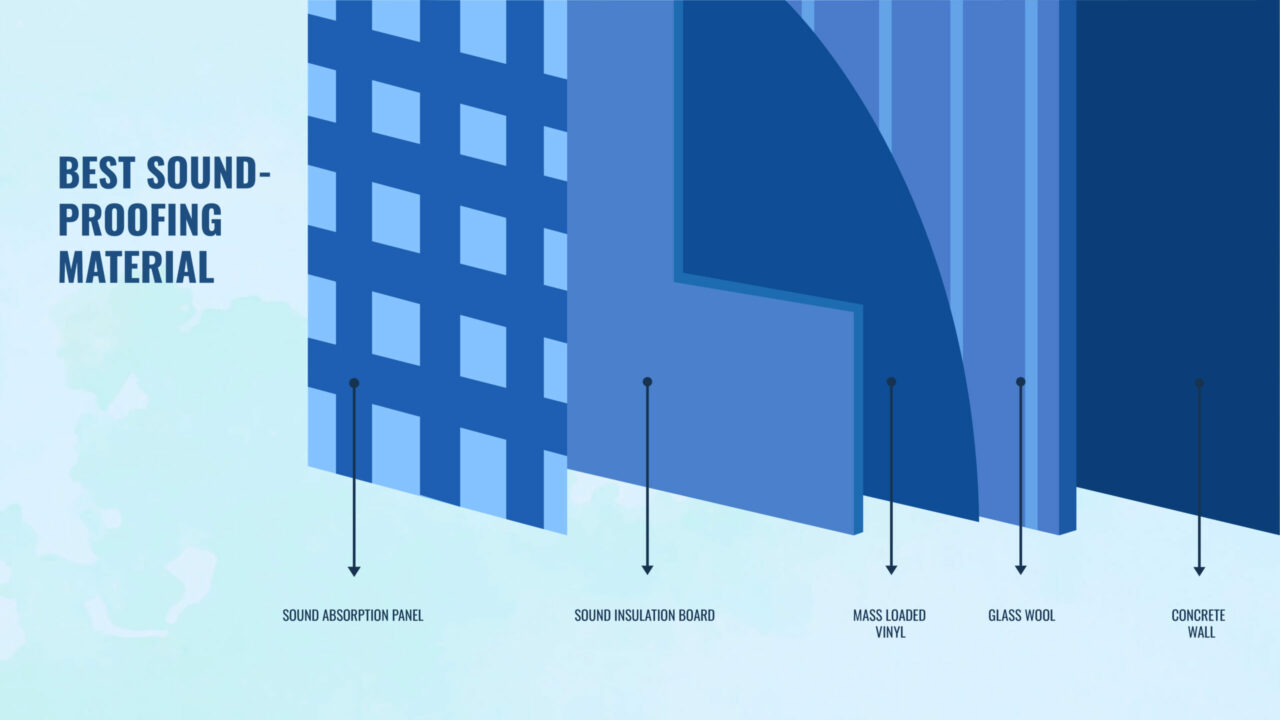
Mass loaded vinyl (MLV) is a thick and flexible mat or sheet made loaded with heavy particles (usually metal) that allow more mass to be added to walls or the ceiling to insulate sounds.
In addition to weakening noise, it can function as a thermal solution that can keep your space warmer during the winter season.
Using MLV is one of the easiest ways to double up on these soundproofing techniques. You can install MLV:
- Behind furniture.
- Behind soundproof blankets and beneath carpets (if you live on the second floor or anywhere above the first floor).
- On the wall, then cover it with curtains.
- Under soundproof padding (more information below).
4. Use Acoustic Foam Panels or Acoustic Wall Tiles as Soundproof Padding
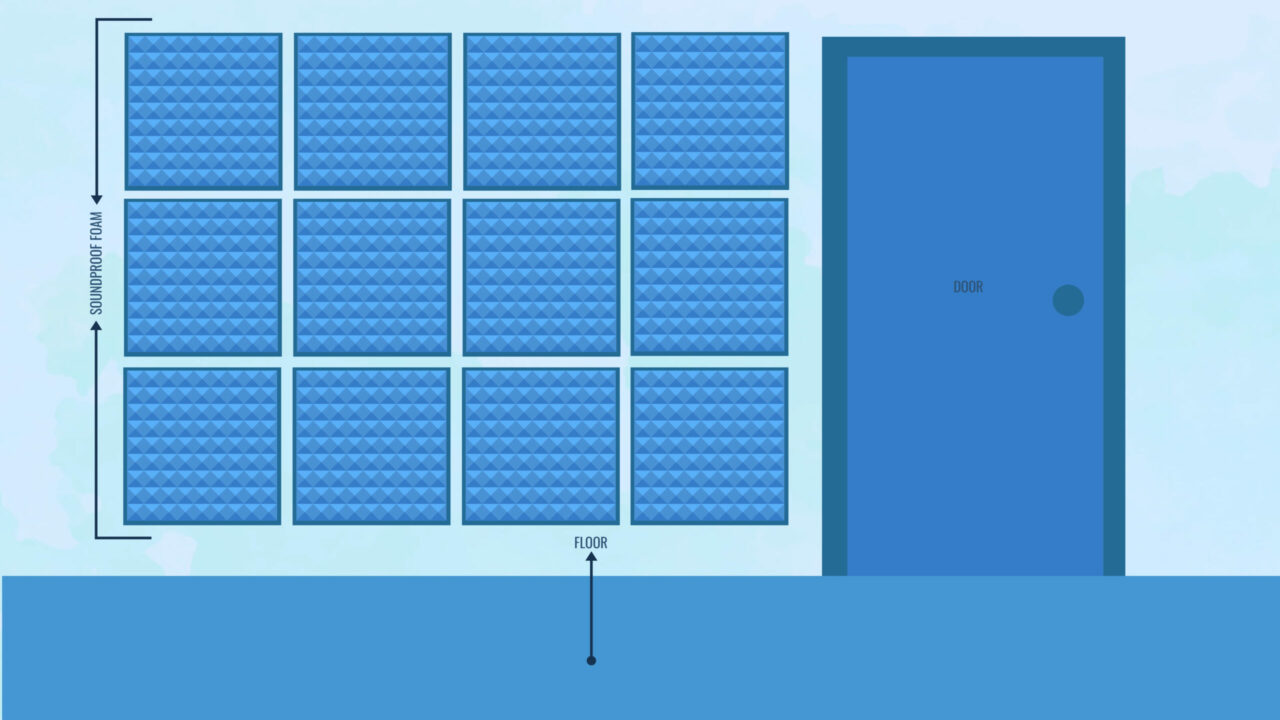
Acoustic foam panels and acoustic wall tiles are usually used in music studios but have become increasingly popular with the general public and are content creator favorites.
Admittedly, these padding solutions are more effective at keeping interior sounds within your room’s walls rather than blocking external noise from entering your apartment.
They’re great for bumping your privacy (as noise coming through thin walls works both ways). Plus, you can use these in conjunction with other techniques for better soundproofing.
5. Add Extra Layers of Drywall

The thinness of your apartment wall is probably the biggest reason for undesired noise. You can reinforce its ability to filter sounds by adding more obstructions to its path.
Check out our article on the best soundproof drywall to guide you on how to use plasterboards to help with sound masking and noise reduction in your apartment.
6. Seal Cracks and Holes With Green Glue
Older apartment buildings may house units with holes and cracks through the walls where cables, for example, used to be placed. These are safe and normal features.
However, noise can easily travel through these gaps, and they need to be sealed for soundproofing. Green Glue is an effective acoustic sealant you can use for this purpose!
If there are nail holes where people used to hang pictures or fasten other household items, Green Glue can also be used. There are a few kinds, so pick one that is best for your home.
7. Add a Coat of Soundproofing Paint to Thin Walls
Soundproofing paint is paint saturated with soundproofing properties. On its own, it isn’t the most effective solution, but we recommend using it in conjunction with other techniques.
Soundproofing paint is particularly good at insulating low frequencies. These are those thumping basses that a younger neighbor who likes partying might produce.
Alternative Solutions to Soundproofing Thin Walls
Constructing Thicker Soundproof Walls
You can extend an existing wall to prevent unwanted noises from coming through. Adding a few inches of insulation can significantly help, and you’ll only need a few things.
Be sure to read our guide on how to soundproof walls before starting your project! You can find some handy tricks there to help you.
If you are considering this option, clear it up with your building manager first if it is possible. There may be safety issues that prevent you from going ahead.
Get a White Noise Machine
If none of the options we have listed works for you, try looking into white noise machines to create background noise that can distract you from the other noises present.
A white noise machine can mask these sounds and are also great for promoting easy sleep. You can also use one on top of the other soundproofing techniques we have mentioned.
Why Should I Soundproof My Walls?
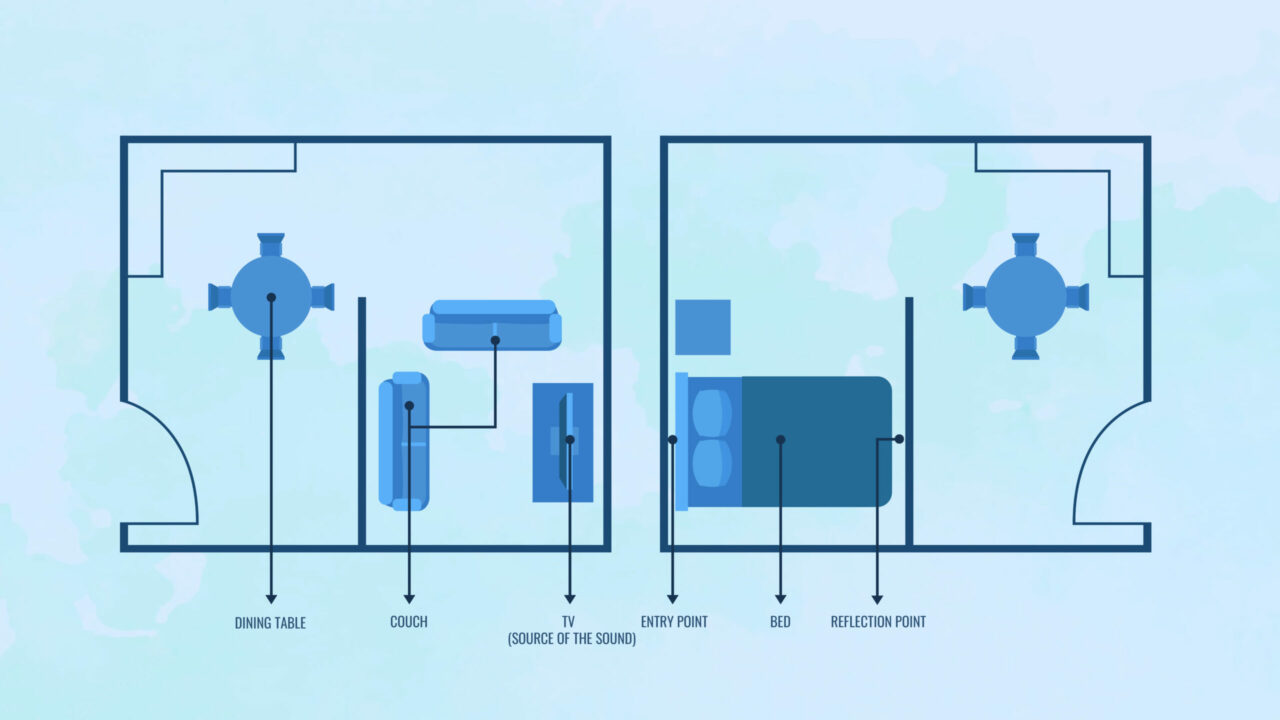
Uncontrolled noise levels in your home can disrupt life in many ways. Here are some reasons why you should reduce them:
- Better rest. Falling asleep and staying asleep undisturbed through the night will be much easier for the whole family (especially if you have a baby).
- Privacy. Just as much as you don’t want to hear your neighbor’s phone calls, you wouldn’t want them to hear yours!
- Better environment for focus and leisure. Working or relaxing is smoother without hearing incessant music or TV murmurs.
There are other reasons, of course, but the bottom line is it can make life significantly more comfortable.
Myths About Soundproofing Apartment Walls
To avoid being disappointed by a soundproofing project, you need to set realistic expectations on how much airborne sound, impact sound, and other sounds you can eliminate from a space.
The first thing to understand is that using sound absorption materials on a shared wall is not the same as properly soundproofing, which is more costly and requires a professional touch.
As sound travels through an existing window or the front door, for instance, street noise coming from outside can be heard. This and other noises can be blocked by soundproofing.
On the other hand, sound-absorbing materials can only prevent sound bouncing between hard surfaces. This means reducing the echo of the external sounds from a room.
The latter treatment, in effect, can indeed lower the noise transmitted between thin walls. For leasees and those currently strapped for money, adding mass to these walls is the best bet.
However, these solutions cannot replicate the level of noise blocking that actual soundproofing does. It CAN get costly, but it might be a worthy investment for peace and quiet.
Here are a few more myths about soundproofing thin walls to be aware of so you can save some time and energy:
1. Acoustic Panels Can Help Paper Thin Walls Completely Block Sound
If the acoustics of a room matter to you, this is a good option to use and can be done on top of soundproofing. As mentioned earlier, it lessens echo and is great for privacy.
However, acoustic panels don’t actually reduce the noise level from external sources. This is because they absorb sounds rather than outright blocking them.
2. Pillows Can Soundproof Apartments
This myth probably shares some similar principles to the one above because both materials are made up of soft particles. However, they also share the same downfall!
When it comes to soundproofing, soft things do not address the structural deficiencies that a thin wall has. Hence, they are not the best solutions to the problem (at least not alone).
3. Furniture Placement Is the Answer to Everything
Cleverly installing some furniture can definitely help, as it introduces more obstacles to a sound’s path before reaching your space, but the technique is not sufficient by itself.
This is why our advice when employing the soundproofing solutions we listed earlier is to use a combination of them. Doing so will result in a better situation than just using one!
FAQs
Here are answers to a couple of questions commonly asked about soundproofing shared walls:
How Can I Soundproof an Apartment Cheaply?
Soundproofing your apartment using the techniques above would save you so much more time and money than having a professional come in and do it.
Though the results probably won’t be on par with the work of someone trained, it can get you to a pretty good place if you use a handful of them to support each other.
Do read our full room-soundproof guide and apply the tips and tricks to your entire apartment for a more peaceful living space.
How Much Does It Cost to Soundproof My Apartment Walls?
If you plan on going for any of the solutions we talked about, the actual costs would depend on which ones you pick and where you buy materials. But they are generally pretty affordable.
If you would rather have a professional do it for you, your expenses can go from a few hundred to a few thousand dollars. Keep in mind that your apartment might not allow this.
Conclusion
Thin apartment walls do not allow for dead space in between needed to totally block out sounds. Airborne and impact noises can easily pass through, creating an uncomfortable space.
With the help of soundproofing materials widely available today, you can make use of some techniques that will help reduce undesired noises that get through your apartment wall!
Note that truly soundproofing a wall is the job of a professional. It might be worth it for you, but they can be costly, and not every building will allow construction work to be done to their walls.
If none of those options are applicable to you, white noise machines can offer some level of comfort as an alternative.
We hope these acoustical solutions will give you the apartment therapy you need for some peace and quiet!


